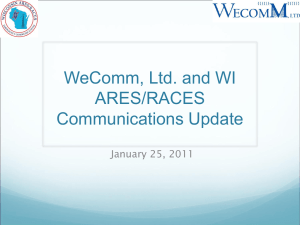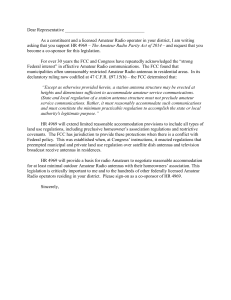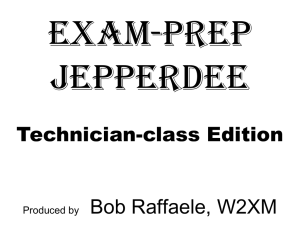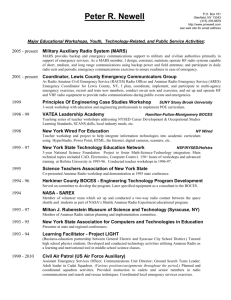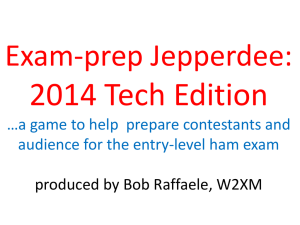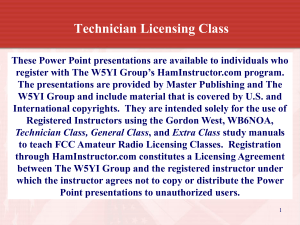Module 1 – Introduction C1
advertisement
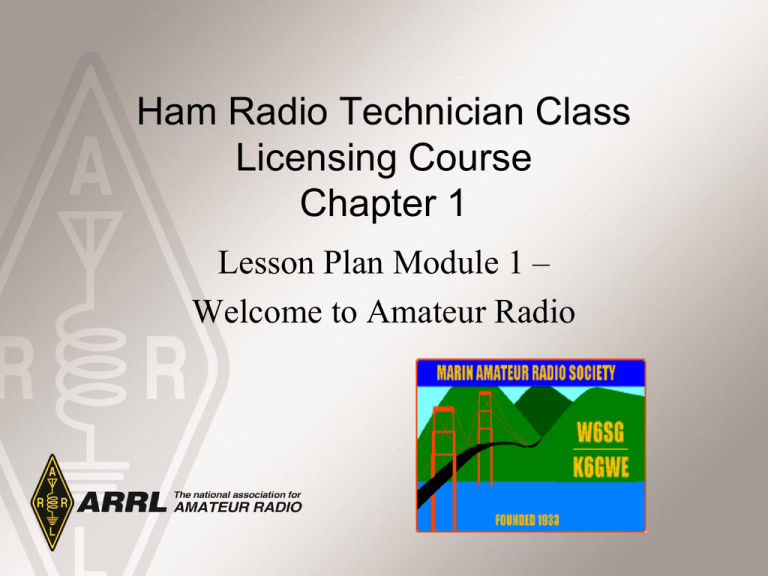
Ham Radio Technician Class Licensing Course Chapter 1 Lesson Plan Module 1 – Welcome to Amateur Radio Introductions • • • • State your name and a little about yourself. Why are you taking this course? What do you know about ham radio? What expectations do you have for yourself and your instructors? Your Instructors: • Dave Hodgson KG6TCJ Amateur Extra Class • Randy Jenkins KA6BQF Amateur Extra Class • Doug Slusher KF6AKU Technician Class Course Overview • Welcome to Amateur Radio (1 hour) • Radio and Signal Fundamentals (4 hours) • Electricity, Components, and Circuits (5 hours) • Propagation, Antennas, and Feed Lines (5 hours) • Amateur Radio Equipment (4 hours) • Communicating with Other Hams (4 hours) • Licensing Regulations (4 hours) • Operating Regulations (2 hours) • Safety (2 hours) Expectations • Class will start and end on time. • Instructor will be prepared to teach. • Students are expected to read assigned material before each class session and be prepared to learn. • Ham radio is not a spectator sport. Active participation during class discussions is vital to success in obtaining your Technician Class License (ticket). Let’s Get Started • Our goal during this class is for each of you to achieve the Technician Class Amateur Radio License! – The license will authorize you to operate an Amateur Radio (Ham Radio) transmitter. What is Amateur Radio? • Amateur (or Ham) Radio is a personal radio service authorized by the Federal Communications Commission (FCC). – To encourage the advancement of the art and science of radio. – To promote the development of an emergency communication capability to assist communities when needed. – To develop a pool of trained radio operators. – To promote international good will by connecting private citizens in countries around the globe. • Through ham radio, you will become an ambassador for your community and your country. What Do Hams Do? • • • • • • • Communicate Participate Experiment Build Compete Serve their communities Life-long learning What Makes Ham Radio Different? • There are many unlicensed radio services available. (Family Radio Service, Citizens Band) • Ham radio is authorized: – – – – – Fewer restrictions. More frequencies (channels or bands to utilize). More power (to improve range and quality). More ways to communicate. It’s free to operate your radio. With More Privileges Comes More Responsibility • Because ham radios are much more capable and have the potential of interfering with other radio services. • Because ham radios have unlimited reach. They easily reach around the globe and into space. • FCC authorization is required to ensure the operator is qualified to operate the ham radio safely, appropriately and within the rules and regulation – that is why you are here. Steps to Obtaining Your Ticket • Study the material in the Ham Radio License Manual. • Review the questions in the back of the book • Take interactive practice exams. • Pass a proctored 35-question multiple choice test. – Questions pulled directly from the question pool. – Need to answer 26 questions correctly. • No Morse code is required. For whom is the Amateur Radio Service intended? (T1A01) • A. Persons who have messages to broadcast to the public • B. Persons who need communications for the activities of their immediate family members, relatives and friends • C. Persons who need two-way communications for personal reasons • D. Persons who are interested in radio technique solely with a personal aim and without pecuniary interest For whom is the Amateur Radio Service intended? (T1A01) • A. Persons who have messages to broadcast to the public • B. Persons who need communications for the activities of their immediate family members, relatives and friends • C. Persons who need two-way communications for personal reasons • D. Persons who are interested in radio technique solely with a personal aim and without pecuniary interest What is the FCC Part 97 definition of an amateur station? (T1A10) • A. A station in an Amateur Radio Service consisting of apparatus necessary for carrying out radio communications • B. A building where Amateur Radio receivers, transmitters, and RF power amplifiers are installed • C. An radio station operated by a nonprofessional • D. Any radio station for hobby use What is the FCC Part 97 definition of an amateur station? (T1A10) • A. A station in an Amateur Radio Service consisting of apparatus necessary for carrying out radio communications • B. A building where Amateur Radio receivers, transmitters, and RF power amplifiers are installed • C. An radio station operated by a nonprofessional • D. Any radio station for hobby use What agency regulates and enforces the rules for the Amateur Radio service in the United States? (T1A02) • • • • A. B. C. D. FEMA The ITU The FCC Homeland Security What agency regulates and enforces the rules for the Amateur Radio service in the United States? (T1A02) • • • • A. B. C. D. FEMA The ITU The FCC Homeland Security So Let’s Begin Your Ham Radio Journey • We have touched briefly on what ham radio is. More detail will follow in the weeks to come. • Reading assignment: Introduction and Chapter 1 – this covers materials presented in the first hour already. • Chapter 2.
